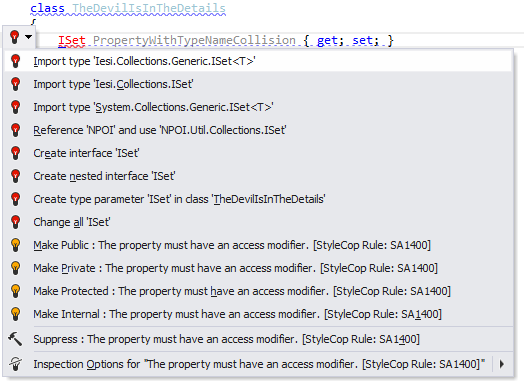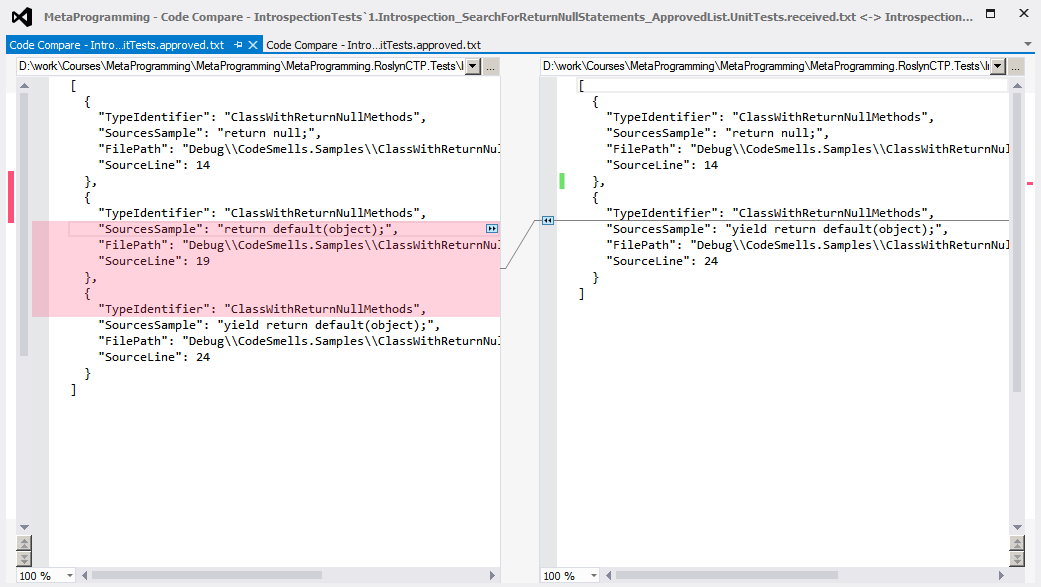Architecture and Design Validation in .Net
Architecture
As a noun architecture can be summarised as being about structure
and is about the decomposition of a product into
a collection of components and interactions.
Software Architecture for Developers by @simonbrown
Validation
The assurance that a product, service, or system meets the needs of the customer and other identified stakeholders
Parkinson's law of triviality
Organizations give disproportionate weight to trivial issues
by Cyril Northcote Parkinson
- The first is the signing of a £10 000 000 contract to build a reactor (2 min)
- the second a proposal to build a £350 bicycle shed for the clerical staff (45 min, save ~50£)

more at bikeshed.com
Why?
- Project context: Hot/Cold starts
- Coding Convention vs. Coding by Convention
- Static Typing: Compiled ≠ Ready
Type Name Collisions

What to choose: Iesi.Collections.ISet,
System.Collections.Generic.ISet or
NPOI.Util.Collections.ISet?
Fail fast!
A fail-fast system is designed to immediately report any failure or condition that is likely to lead to failure
Test Drive the System Architecture
Test Driven DevelopmentFirst we'll solve the "that works" part of the problem, then we'll solve the "clean code" part
Architecture Driven DevelopmentSolve "clean code" first, then scramble around trying to integrate into the design the things you learn as you solve the "that works" problem
TDD by examples by @kentbeckReflection vs. Introspection
C# code and syntax tree
From Roslyn CTP
public object ReturnNullReferenceType() { return null; }

Search for return null;
Func<StatementSyntax, bool> returnNullStatement = PredicateBuilder .True<StatementSyntax>() // all return statements .And(s => s is ReturnStatementSyntax) // with expression .And(s => (s as ReturnStatementSyntax).Expression != null) // with expression "null" .And(s => (s as ReturnStatementSyntax).Expression.Kind == SyntaxKind.NullLiteralExpression) .Compile();
Search for return default(T);
Where T is reference type
ExpressionSyntax expressionSyntax = (statement as ReturnStatementSyntax).Expression; ISemanticModel semanticModel = await semanticModelAsync; return expressionSyntax != null && (semanticModel.GetTypeInfo(expressionSyntax).Type == null || semanticModel.GetTypeInfo(expressionSyntax).Type.IsReferenceType);
Advanced samples
IEnumerable<T>orIQuerable<T>
- Constructor-over injection or
newin constructor
- Singletons
- Verify declarative
[Attribute]composition
DateTime.NowandDateTime.Today
Limit references to assemblies
Using System.Reflection
[Test, Combinatorial] public void TestReferencesIntersection( [ValueSource("Assemblies")] Assembly leftAssembly, [ValueSource("Assemblies")] Assembly rightAssembly) { if (leftAssembly == rightAssembly) return; var rightReferences = FilterOutAssemblies(rightAssembly); var leftReferences = FilterOutAssemblies(leftAssembly); Assert.That(leftReferences.Intersect(rightReferences), Is.Not.Null.And.Empty); } private static IEnumerable<string> FilterOutAssemblies(Assembly source) { return new HashSet<string>(source .GetReferencedAssemblies() .Where(assembly => assembly.Name != @"mscorlib" && assembly.Name != @"Microsoft.CSharp" && !assembly.Name.StartsWith(@"System") && !assembly.Name.StartsWith(@"AutoMapper") && !assembly.Name.StartsWith(@"nCrunch.TestRuntime") && !assembly.Name.StartsWith(@"PostSharp")) .Select(assembly => assembly.Name)); }
Limitations
- C#/VB.Net source code should be available
- Support of C# features:
dynamic,async/await - When Roslyn CTP will be released? At least it will not replace existing compiler in VS2013 :'(
Assertions
- How to references back to sources?
- What to do if source code has been changed?
ApprovalTests
Capturing Human Intelligence

Performance/complexity testing
[Test, Timeout(2000)] // <-- brittle unit tests!!! [Description("Find collinear points among 1000 random distinct points")] public void Timing_FindCollinearPoints1kRandomDistinctPoints_ExpectToFinishIn2Seconds() { /* Actual test */ }
Algorithms timing/complexity testing
- Maximum time allowed per test = N seconds
- Ratio tests: 64, 128, 256, 1024…
- Partial mocks and
virtual/overrideEquals(),GetHashCode(),CompareTo()
Algorithms complexity testing
[Test, Timeout(2000)]
[Description("Compare complexity of two solutions of sizes 64 and 256 to be less then 5.4")]
public void Timing_CompareComplexityOfTwoSolution64and256_ExpectToInRange()
{
var partialMockedProblem64 = mockRepository.PartialMock<AlgorithmImpl>(/* initialize problem size */);
var partialMockedProblem256 = mockRepository.PartialMock<AlgorithmImpl>(/* initialize problem size */);
/* and so on… */
partialMockedProblem64
.Expect(m => m.DoCalculations(/* arguments */))
.CallOriginalMethod(OriginalCallOptions.CreateExpectation)
.WhenCalled(invok => nTimesDoCalculationsCalledProblem64++)
.Repeat.AtLeastOnce();
/* and so on… */
mockRepository.ReplayAll();
/* Act */
/* Assert */
mockRepository.VerifyAll();
var cmp64 = nTimesDoCalculationsCalledProblem64 * Math.Log(nTimesDoCalculationsCalledProblem64);
var cmp256 = nTimesDoCalculationsCalledProblem256 * Math.Log(nTimesDoCalculationsCalledProblem256);
Assert.That(cmp256 / cmp64 < 5.4); /* ask BA with PhD why? :) */
/* and so on… */
}
- Note #01: this is not a replacement for code review!
- Note #02: when to automate?
- Note #03: is this a unittest?
- Note #04: DIY vs. Tools
- Note #05: C# vs. F#
PostSharp: Architecture Constraints
.Net build pipeline
CIL (Common Intermediate Language)
CLR(Common Language Runtime) + Machine Instruction
PostSharp build pipeline
Modified CLI (Common Intermediate Language)
Check constraints
Serialize state for runtime
Architecture Framework
- Built-In Architecture Constraints
- Custom Architecture Constraints
ScalarConstraintandReferentialConstraint
POCO class
class with typical code issues
public class Customer { // This property is defined as expected public virtual int Id { get; set; } // without `virtual` keyword PostSharp will generate compile-time error message // otherwise NHiberante will generate exception during run-time public /*virtual*/ string Name { get; set; } // Both getter/setter are required to be public internal virtual string Description { get; private set; } }
Validate constraint
Validate that all properties are public, virtual with getter and setter
[Serializable] [MulticastAttributeUsage(MulticastTargets.Property)] public class VirtualKeywordRequiredForInstancePropertiesAttribute : ScalarConstraint { // Validation happens only at post-compile phase public override void ValidateCode(object target) { var propertyInfo = (PropertyInfo)target; var targetType = propertyInfo.DeclaringType; if (targetType != null) { // check that property is public, virtual with getter and setter var virtualInstanceProperty = targetType .GetProperties(BindingFlags.Public | BindingFlags.Instance) .Where(propInfo => propInfo.CanRead & propertyInfo.CanWrite) .Where(propInfo => propInfo.GetGetMethod().IsVirtual) .Where(propInfo => propInfo.GetSetMethod().IsVirtual) .SingleOrDefault(propInfo => propInfo == propertyInfo); // generate compile time error if (virtualInstanceProperty == null) { Message.Write(MessageLocation.Of(targetType), SeverityType.Error, "998", "Property '{0}' in Entity class {1} show be public, virtual with both getter and setter", propertyInfo.Name, targetType.FullName); } } } }
Multicasting
// Multicast aspect to all properties of classes in namespace
[assembly: VirtualKeywordRequiredForInstanceProperties(
AttributeTargetTypes = "CodeSmells.FakeDataAccessLibrary.Entity.*",
AttributeTargetElements = MulticastTargets.Property)]
Compile-time error
Error generated by PostSharp aspect validation

Advanced samples
- Authentication using HMAC
- Declarative multithreading with PostSharp
Limitations
- License for PostSharp 2 and 3
- Configuration issues
If you perceive that there are four possible ways in which something can go wrong,
and circumvent these, then a fifth way, unprepared for, will promptly develop
by Edward Aloysius Murphy
References
- Microsoft® “Roslyn” CTP
- PostSharp — Design Pattern Automation
- Metaprogramming in .NET by @KevinHazzard and @JasonBock
- AOP in .NET: Practical Aspect-Oriented Programming by @mgroves
